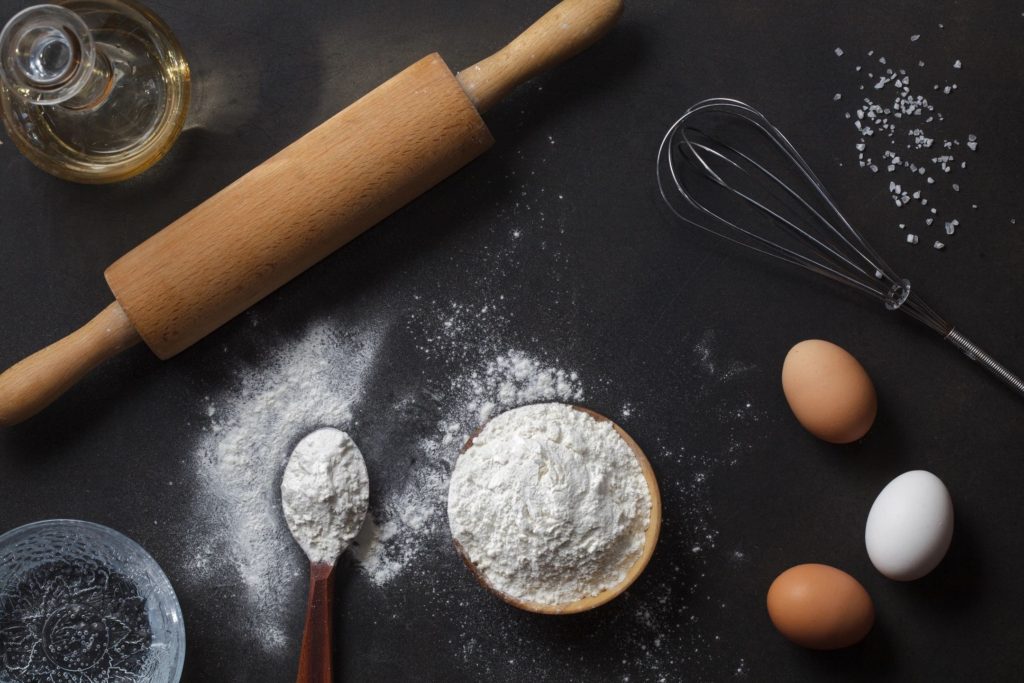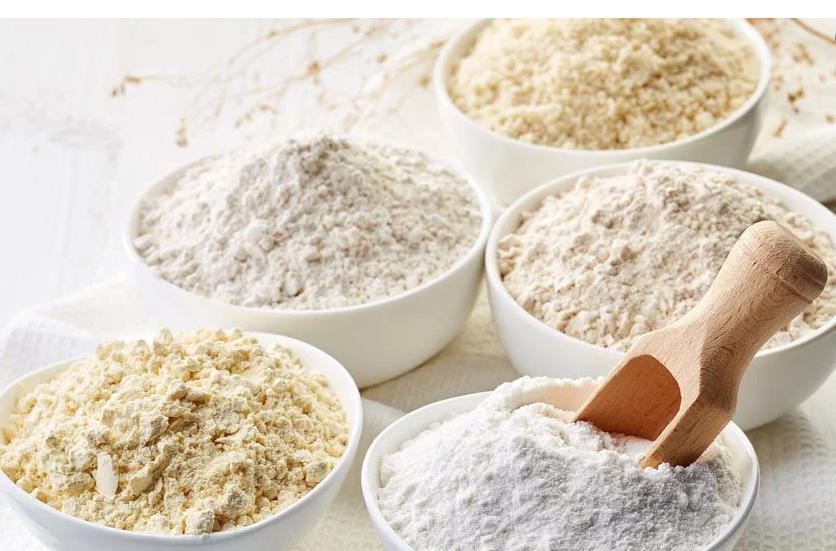Flour, Flour and More Flour: A Flour Guide
 I have been remiss in blogging lately. My only excuse is….life. Like everyone else, we are overbooked. I have been cooking and photographing and I will get some blogs done soon. In the meantime, I found a great article on different types of flour on another blog site, so I wanted to share that with you here. The original article can be found here.
I have been remiss in blogging lately. My only excuse is….life. Like everyone else, we are overbooked. I have been cooking and photographing and I will get some blogs done soon. In the meantime, I found a great article on different types of flour on another blog site, so I wanted to share that with you here. The original article can be found here.
Bob’s Red Mill, a specialty flour company, reports it sells more than 70 kinds of flours and meals. King Arthur Flour, another favorite with bakers, sells 56. That’s a lot of flour to sift through.
While we have no problem buying a cookie from our favorite bakery, choosing the right flour for every baking project can be a daunting task. So we turned to a few culinary experts in hopes of demystifying flour’s many varieties.
Known for taking unique twists on nostalgic desserts, Brian Mercury, executive pastry chef at Harvest in Cambridge, Massachusetts, spends a great deal of time thinking about flour. He takes into consideration several qualities: flavor, texture, nutrition and end product. Mercury is a big fan of those lesser-known flours, which we’ll also cover here. “Using alternate flours is a great way to add unexpected flavor to common recipes,” he says.
We also consulted a pair of Boston chefs working to bring Venetian pasta to the south end of town at newly opened SRV. Co-executive chefs Kevin O’Donnell and Michael Lombardi are so flour-forward that they mill their own grains in-house.
Here’s a rundown of the common flours you’ll find easily in stores and some you might need to buy online, along with recipe suggestions and the best tips we’ve gleaned from our experts.
Flours with Gluten
All-purpose flour: This kitchen workhorse has a very high percentage of gluten, which is a form of protein. It also has the chemical composition that helps your edibles rise and gives them better elasticity. All-purpose flour can be bought both bleached and unbleached. O’Donnell and Lombardi always recommend unbleached flour when cooking at home. “While bleaching creates a softer texture, it loses the nuance and the original expression of the wheat,” the chefs say. Flours with higher protein content are good for items that need a firmer structure and those you don’t want to deflate. Try making popovers or this easy little apple galette.
Whole wheat flour: Made from the whole kernel of the wheat grain—bran, germ and endosperm—whole wheat flour is higher in dietary fiber than white flour and has a better nutritional profile. What it lacks is a high level of gluten. Because of this you might find it blended with all-purpose flour to make a better bread, porridge or cookie.
Semolina flour: Used for making pasta, this course grind has the highest gluten level of any durum wheat. It has a nutty, sweet flavor and typically a pale yellow color. Sprinkle it on a baking sheet (in place of cornmeal) to avoid items sticking or boil it for a warm breakfast cereal. You can also make this fennel and semolina cake, or try these dumplings.
Pastry flour: Also called cake flour, this low-protein flour is made for baking with other leavening agents, like baking powder and soda. Pastry flour makes your pastry light but crumbly. Think biscuits, piecrusts, brownies and cookies. This Southern-style biscuit recipe calls for all-purpose flour, but swap one cup plus two tablespoons of pastry flour for every cup of all-purpose flour, and you’ll learn that you can safely replace ingredients.
Durum flour: O’Donnell and Lombardi recommend using durum flour for all of your pasta needs. Dough made from durum is less elastic, which makes it a perfect companion to a rolling pin. In addition to its high gluten content, the SRV chefs say, “It will give your pasta that traditional chew you get in restaurants, and the color of the wheat gives it a more beautiful pasta color.” Feeling inspired? Try our chapati flatbread.
Spelt flour: This increasingly popular flour, sometimes referred to as an ancient grain, is a distant relative of durum and can even be found in Cheerios. One of the reasons it’s so popular is the nutritional content, which beats traditional flour. Spelt holds its texture and shape, but it has a mild and slightly sweet flavor. It works well as a replacement to wheat flour and will give your products a light, soft texture. Don’t be scared, but here’s a recipe to make your own pasta.
Barley flour: Made from whole barley, this flour isn’t related to wheat, yet it still contains some gluten. The high-fiber flour is mild with a hint of a nutty taste. By using barley flour instead of all-purpose flour, you triple your fiber intake. Because it’s low in gluten, it isn’t great for anything you need to rise. If you do use it, we suggest blending it with all-purpose flour in these pumpkin and pecan pancakes.
Rye flour: This low-gluten flour comes in a variety of hues, depending on the milling process. The rich-tasting grain is high in nutrients, because it retains much of its bran. A general rule for using rye flour in everyday baking is to swap out one-third of the called-for flour with rye. Be like Chad Robertson and make these salted chocolate-rye cookies.
Kamut flour: Mild and sweet, this flour—another ancient grain—has a hint of a buttery taste. The fine flour has a high mineral concentration and can be used to swap out wheat flour with relative ease. Even better? The low-carb, high-protein flour will leave you feeling healthy, even after you eat these flax seed muffins.
Gluten-Free Flours
Almond flour: Made from blanched, skinless almonds, this flour is a good swap at one-quarter of the amount called for and adds moistness. Look for finer milled flour if you want to minimize the gritty texture of the end product. Nut flours can brown quickly. “If you’re concerned about it coloring too fast, you can drop the temperature of the oven or even cover an exposed portion while baking,” Mercury says. This maple parsnip cake is perfect for those winter root vegetables you don’t know what to do with.
Millet flour: This sweet, mild-tasting flour is high in essential amino acids and fiber. Millet flour has a little claim to fame: It’s an alkaline grain, which some nutritionists point to as being softer on our digestive systems than other grains. It’s most often used in cakes, cookies and porridge, like this millet kheer, but in a pinch it can go savory, like in these millet fritters.
Amaranth: Amaranth is another one of those good-for-you ancient grains. This nutty-tasting grain contains more protein than any other gluten-free option. Shoot for replacing up to 25 percent of the flour used in your recipe with amaranth, and then check off your healthy quota for the day.
Quinoa flour: This much-talked-about flour is a complete protein with all nine essential amino acids. Mercury loves to use it as a base for his desserts. The pastry chef uses red quinoa for its deep, warming flavors, like in a sticky toffee pudding, and he uses white quinoa, which is lighter and tastes more almond-y, with yogurt and citrus. Try replacing a quarter of the flour called for in these cherry vanilla scones.
Buckwheat: This nutty flour includes your essential amino acids and is ridiculously versatile. Whether it’s due to its origin––its not actually a grain or grass, but rather a fruit—or its high protein content, using this flavorful flour will make you feel like a pro. Buckwheat is the main ingredient in soba noodles and blini, two great examples that use the nimble ingredient.
Teff: This gluten-free flour comes from a grass seed, not a grain, and lends itself well to desserts. Of all the flours, teff is the highest in calcium, in case you’re counting. Mercury uses it to great success in his chocolate desserts, because of its molasses-like flavor. Try these chocolate, orange and beet brownies with it, and you’ll soon be a convert.
Chickpea flour: Made from ground chickpeas (aka garbanzo beans), this gluten-free flour is your savory best friend. The flour is loaded with protein and fiber, and when all-purpose flour is called for, you can safely replace up to half of it with chickpea flour. The taste lightly evokes chickpeas but should safely hide out in most every dish.
Corn flour: Not to be confused with cornmeal, which is much grittier, this flour is rather miraculous. Look for the whole-grain version, which will be far more nutritious and packed with tons of fiber. This blueberry galette recipe calls for only a bit of corn flour, but don’t be afraid to experiment, Mercury says. “Always cook and bake with your eyes, hand and mind.”
Rice flour: With a high starch content and an elasticity that approaches wheat, rice flour is a great baking choice for those hard-to-please gluten-free friends. It also has a neutral flavor that will allow your other ingredients to shine. These matcha cookies look positively dreamy and will have you showing off with both almond and sweet rice flour.
Sorghum: This flour ranges from light brown, which has a neutral taste, to dark brown, which has an earthier flavor. It’s great for baking and takes well to blending, say, with buckwheat flour. “I feel it gives a depth of flavor and a little unexpected twist to classic items,” Mercury says. Try swapping out a portion of the flour called for in this recipe for a chocolate coffee cake.
Tapioca flour: You might know this flour best for its appearance in your favorite bubble tea, but this fine white powder—made from the tapioca root—is great for baking. Be careful, Mercury warns, too much tapioca can make your baked goods go “gummy.” But measured just right, and tapioca flour will give your treats an airy, chewy texture and a crispy crust. It’s also a great thickener in sauces and can be swapped in for cornstarch, like in this Meyer lemon soufflé.
TigerNut Flour: Not a nut and not a seed, but rather a small tuber, this Paleo-friendly, gluten-free flour is the newest thing to hit the baking world. Fans of the flour like it for its great fiber content and its balanced ratio of fat and carbs to protein, levels that are much like those found in olive oil. TigerNut Flour also has as much potassium as coconut water and is high in iron and rich in vitamin E and oleic acid. You can use it in recipes that are dense, like cookies and brownies, in a one-to-one ratio when substituting for white flour. Don’t be surprised to hear that this offbeat flour comes from a company in Brooklyn, but if you want some, you’ll have to go to Amazon.

